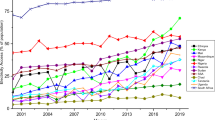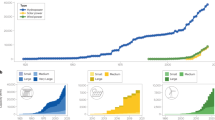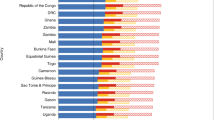Abstract
Pioneering approaches are needed to accelerate universal access to electricity while simultaneously transitioning to reliable, sustainable and affordable energy systems. In sub-Saharan Africa (SSA), the challenges lie in attracting the private sector to complement public investments. Here, we present an integrated ‘low-hanging-fruit’ approach aimed at boosting private investment and speeding up the deployment of renewable energy systems in SSA. We analyse the potential of existing energy infrastructure, where a significant upfront investment has already been made, to be exploited for electricity generation. We develop a comprehensive methodology to identify and select suitable locations in SSA and estimate their potential for exploitation. These locations have been further analysed in terms of power capacity potential, electricity output, investments needed and population to be benefited. This strategy to attract additional finance can easily be reproduced, engaging private investors while simultaneously helping to achieve the United Nations (UN) Sustainable Development Goals on energy.
This is a preview of subscription content, access via your institution
Access options
Subscribe to this journal
Receive 12 digital issues and online access to articles
$119.00 per year
only $9.92 per issue
Buy this article
- Purchase on Springer Link
- Instant access to full article PDF
Prices may be subject to local taxes which are calculated during checkout




Similar content being viewed by others
References
Africa Energy Outlook. A Focus on Energy Prospects in Sub-Saharan Africa World Energy Outlook Special Report (International Energy Agency, 2014).
Showers, K. B. in Engineering Earth: The Impacts of Megaengineering Projects (ed. Brunn, S. D. ) Ch. 95 1651–1679 (Springer, 2011).
DRC Inga 3 and Mid-Size Hydropower Development Implementation Status & Results Report (The World Bank, 2015).
International Energy Statistics (US Energy Information Administration, 2015); http://www.eia.gov/beta/international
Addressing the Electricity Access Gap Background Paper for the World Bank Group Energy Sector Strategy (The World Bank, 2010); http://siteresources.worldbank.org/EXTESC/Resources/Addressing_the_Electricity_Access_Gap.pdf
Alstone, P., Gershenson, D. & Kammen, D. M. Decentralized energy systems for clean electricity access. Nat. Clim. Change 5, 305–314 (2015).
Foster, V. & Briceño-Garmendia, C. Africa Infrastructure: A Time for Transformation (The World Bank, 2010); http://documents.worldbank.org/curated/en/2009/01/11487313/africas-infrastructure-time-transformation
Sebitosi, A. B. & Okou, R. Re-thinking the power transmission model for sub-Saharan Africa. Energy Policy 38, 1448–1454 (2010).
Least Cost Power Development Plan and Scaling-Up Renewable Energy Program (SREP) Joint Development Partner Scoping Mission (Kenya Energy Regulation Commission, 2011); https://www-cif.climateinvestmentfunds.org/sites/default/files/Kenya_post_mission_report_March_10_2011.pdf
Elaboration du Programme d’Èlectrification Rurale (Burkina Faso Ministére des Mines des Carriéres et de l’Energie, Exaltis, and Deutsche Energie-Consult Ingenieurgesellschaft GmbH, 2008).
Zambia Rural Electrification Master Plan (REA, 2013); http://www.rea.org.zm/index.php/2013-08-24-13-50-58/remp
Kebede, E., Kagochi, J. & Jolly, C. M. Energy consumption and economic development in Sub-Sahara Africa. Energy Econ. 32, 532–537 (2010).
Sustainable Energy for All 2015 - Progress Toward Sustainable Energy (The Mobile Economy Sub-Saharan Africa, 2015); http://gsmamobileeconomy.com/ssafrica
Sachs, J. D. From millennium development goals to sustainable development goals. Lancet 379, 2206–2211 (2012).
Szabó, S., Bódis, K., Huld, T. & Moner-Girona, M. Energy solutions in rural Africa: mapping electrification costs of distributed solar and diesel generation versus grid extension. Environ. Res. Lett. 6, 034002 (2011).
Bhattacharyya, S. C. Review of alternative methodologies for analysing off-grid electricity supply. Renew. Sustain. Energy Rev. 16, 677–694 (2012).
Williams, N., Jaramillo, P., Taneja, J. & Ustun, T. S. Enabling private sector investment in microgrid-based rural electrification in developing countries: a review. Renew. Sustain. Energy Rev. 52, 1268–1281 (2015).
Mandelli, S., Barbieri, J., Mereu, R. & Colombo, E. Off-grid systems for rural electrification in developing countries: definitions, classification and a comprehensive literature review. Renew. Sustain. Energy Rev. 58, 1621–1646 (2016).
International Year of Sustainable Energy for All (United Nations, 2012); http://www.se4all.org/resources_strategy-documents
African Energy Leaders Group (African Development Bank Group, 2015); http://www.afdb.org/en/news-and-events/article/cote-divoires-president-launches-west-african-energy-leaders-group-14482
Sustainable Energy for All 2015. Progress Toward Sustainable Energy (International Energy Agency and The World Bank, 2015).
Szabó, S., Bódis, K., Huld, T. & Moner-Girona, M. Sustainable energy planning: leapfrogging the energy poverty gap in Africa. Renew. Sustain. Energy Rev. 28, 500–509 (2013).
Szabó, S., Jäger-Waldau, A. & Szabó, L. Risk adjusted financial costs of photovoltaics. Energy Policy 38, 3807–3819 (2010).
Financing Renewable Energy in Developing Countries. Part 3: Financial Risks in a Renewable Energy and Sub-Saharan African Context (UNEP, 2012).
DiPaola, A. UN: African Renewable Energy Projects Stagnating due to Investment Risk (Bloomberg, 2013); http://www.renewableenergyworld.com/news/2013/01/un-african-renewable-energy-projects-stagnating-due-to-investment-risk.html
Jain, A. K. Energy efficiency: low-hanging fruit for India. Forum 99, 34–37 (2015).
Granade, H. C. et al. Unlocking Energy Efficiency in the US Economy (McKinsey & Company Stamford, 2009).
Chum, H. et al. in IPCC Special Report on Renewable Energy Sources and Climate Change Mitigation (eds Edenhofer, O. et al.) Ch. 2 (IPCC, 2011).
Converting Non-Powered Dams (National Hydropower Association, accessed July 2016); http://www.hydro.org/tech-and-policy/developing-hydro/powering-existing-dams
Fitzgerald, N., Arántegui, R. L., McKeogh, E. & Leahy, P. A GIS-based model to calculate the potential for transforming conventional hydropower schemes and non-hydro reservoirs to pumped hydropower schemes. Energy 41, 483–490 (2012).
Hadjerioua, B., Wei, Y. & Kao, S. C. An Assessment of Energy Potential at Non-Powered Dams in the United States Oak Ridge National Laboratory Report (US Department of Energy, 2012).
Medium–Term Renewable Energy Market Report (International Energy Agency, 2015).
Earth at Night (NASA Earth Observatory, accessed April 2016); http://earthobservatory.nasa.gov/Features/NightLights/page3.php
Bailis, R., Ezzati, M. & Kammen, D. M. Mortality and greenhouse gas impacts of biomass and petroleum energy futures in Africa. Science 308, 98–103 (2005).
Mayaux, P., Bartholomé, E., Fritz, S. & Belward, A. A new landcover map of Africa for the year 2000. J. Biogeogr. 31, 861–877 (2004).
EarthStat: Global Landscape Initiative Sugar-Cane Production Data (Univ. Minnesota, accessed July 2016); http://www.earthstat.org/data-download
Ramjeawon, T. Life cycle assessment of electricity generation from bagasse in Mauritius. J. Cleaner Prod. 16, 1727–1734 (2008).
Yin, C., Rosendahl, L. A. & Kær, S. K. Grate-firing of biomass for heat and power production. Prog. Energy Combust. Sci. 34, 725–754 (2008).
Integrated Electricity Plan (2003–2012) (Central Electricity Board, 2003); http://ceb.intnet.mu/CorporateInfo/IEP2003.pdf
Wu, T., Gong, M., Lester, E. & Hall, P. Characteristics and synergistic effects of co-firing of coal and carbonaceous wastes. Fuel 104, 194–200 (2013).
From Billions to Trillions: Transforming Development Finance. Post-2015 Financing for Development: Multilateral Development Finance (World Bank and IMF, 2015); http://siteresources.worldbank.org/DEVCOMMINT/Documentation/23659446/DC2015-0002%28E%29FinancingforDevelopment.pdf
2030 Agenda for Sustainable Development UN Resolution A/70/L.1. (United Nations, 2015); http://www.un.org/ga/search/view_doc.asp?symbol=A/RES/70/1&Lang=E
Energy for All. Financing Access for the Poor Special Early Excerpt of the World Energy Outlook 2011 (International Energy Agency, 2011); http://www.worldenergyoutlook.org/media/weowebsite/energydevelopment/weo2011_energy_for_all.pdf
Kougias, I., Bódis, K., Jäger-Waldau, A., Monforti-Ferrario, F. & Szabó, S. Exploiting existing dams for solar PV system installations. Prog. Photovolt. Res. Appl. 24, 229–239 (2016).
Kougias, I. et al. The potential of water infrastructure to accommodate solar PV systems in Mediterranean islands. Sol. Energy 136, 174–182 (2016).
Liu, H., Masera, D. & Esser, L. World Small Hydropower Development Report 2013 (United Nations Industrial Development Organization, International Center on Small Hydro Power, 2013); www.smallhydroworld.org
Turkenburg, W. et al. in Global Energy Assessment—Toward a Sustainable Future Ch. 11 761–900 (Cambridge Univ. Press, International Institute for Applied Systems Analysis, 2012).
Agricultural Production Data (United Nations Food and Agriculture Organization, 2015); http://faostat3.fao.org/download/Q/*/E
Bódis, K. Development of a Data Set for Continental Hydrologic Modelling. Input Layers Related to Topography, Channel Geometry, Land Cover and Soil Characteristics of European and African River Basins JRC Scientific and Technical Report (European Commission, 2009).
Global Rural-Urban Mapping Project (GRUMP) v1 Settlement Points (SEDAC, accessed April 2016); http://sedac.ciesin.columbia.edu/data/set/grump-v1-population-density
AfriPop v.2013 (Worldpop, accessed April 2016); http://www.worldpop.org.uk
Africa’s Infrastructure: National Data Africa Infrastructure Country Diagnostic (The World Bank, accessed July 2016); http://data.worldbank.org/data-catalog/africa-infrastructure
Huld, T. Photovoltaic Geographical Information system (PVGIS), Geographical Coverage of Extension to Cover All of Africa (EC, DG JRC, Institute for Energy and Transport, 2012); http://re.jrc.ec.europa.eu/pvgis
Renewables 2014 Global Status Report (REN21 Secretariat, 2014).
Updated Capital Cost Estimates for Utility Scale Electricity Generating Plants (U.S. Energy Information Administration, accessed July 2016); http://www.eia.gov/forecasts/capitalcost
Acknowledgements
The views expressed in this paper are purely those of the writers and may not in any circumstances be regarded as statements of an official position of the European Commission.
Author information
Authors and Affiliations
Contributions
S.S. conceived the methodological approach, planned, outlined and led the project. K.B. designed and applied the geospatial decision-making model to identify the analysed energy options, and developed the GIS database for the Supplementary Information. M.M.-G. analysed the finance-policy interactions, I.K. developed the methodology to estimate the hydropower potential and coordinated the analysis of existing dams, R.B. contributed to the bioenergy part, and each of the co-authors contributed equally to composing the final text.
Corresponding author
Ethics declarations
Competing interests
The authors declare no competing financial interests.
Supplementary information
Supplementary Information
Supplementary Methods, Supplementary Tables 1–6, Supplementary Figures 1–11, Supplementary Notes 1–3 and Supplementary References. (PDF 2761 kb)
Rights and permissions
About this article
Cite this article
Szabó, S., Moner-Girona, M., Kougias, I. et al. Identification of advantageous electricity generation options in sub-Saharan Africa integrating existing resources. Nat Energy 1, 16140 (2016). https://doi.org/10.1038/nenergy.2016.140
Received:
Accepted:
Published:
DOI: https://doi.org/10.1038/nenergy.2016.140
This article is cited by
-
Energy planning in Sub-Saharan African countries needs to explicitly consider productive uses of electricity
Scientific Reports (2023)
-
Potential of using floating solar photovoltaic and wind farms for sustainable energy generation in an existing hydropower station in Nigeria
Clean Technologies and Environmental Policy (2023)
-
Optimizing on utility-scale solar for conservation of pristine landscapes and ecosystems: the case of Rodrigues Island
Clean Technologies and Environmental Policy (2022)
-
The economic impact of schistosomiasis
Infectious Diseases of Poverty (2021)
-
Mapping of affordability levels for photovoltaic-based electricity generation in the solar belt of sub-Saharan Africa, East Asia and South Asia
Scientific Reports (2021)



